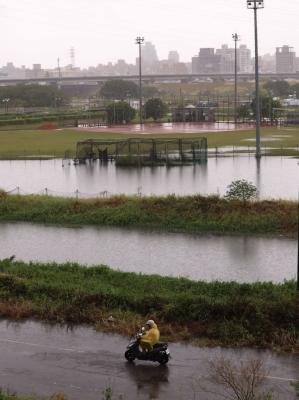With six months to go until next year’s presidential election, the results of an opinion poll released by a local daily yesterday gave President Ma Ying-jeou (馬英九) a six-point lead over Democratic Progressive Party (DPP) Chairperson and presidential candidate Tsai Ing-wen (蔡英文).
The telephone poll conducted by the United Daily News (UDN), a pro-pan-blue paper, found that female voters favor Ma over Tsai, while the latter enjoys a 3 percentage point lead among male voters.
Although more than 60 percent of the respondents said they were concerned about the next presidential election, nearly 70 percent were not aware that the presidential poll would be held simultaneously with the legislative elections on Jan. 14 next year.
In the survey of adults randomly chosen from around the country, 43 percent of the respondents backed Ma of the Chinese Nationalist Party (KMT), while 37 percent said they preferred Tsai.
Among men, 43 percent picked Tsai and 40 percent favored Ma, but among women, Ma had a 46 percent to 32 percent lead.
By age, Ma enjoyed higher support among voters in the 20-29 and 40-59 age groups and was evenly matched with Tsai among voters in all other age brackets.
Regionally, Tsai commanded a comfortable 16 percentage point lead in Yunlin, Chiayi and Tainan, and a 6 percentage point margin in Kaohsiung, Pingtung and Penghu.
Ma outstripped Tsai in the four other major areas — -Taipei, New Taipei City (新北市) and Keelung; Taoyuan, Hsinchu and Miaoli; -Taichung, Changhua and Nantou; and Yilan, Hualien, Taitung, Kinmen and Matsu; by margins ranging between 8 and 19 percentage points.
The UDN poll showed Ma also ahead among potential first-time voters, with a 52-29 percent lead over Tsai. The remaining 19 percent had yet to make up their minds.
Though Ma had a 6 percentage point edge in voter support, there was a much stronger difference of opinion when respondents were asked to pick who would win.
Forty-four percent predicted Ma would win, compared with 23 percent who gave the nod to Tsai. The remaining 33 percent said that it was still too early to predict a winner.
The survey also found that Tsai had a slight edge over Ma in terms of “likability,” scoring 5.6 points on a 0-10 likability scale against Ma’s 5.3 points.
In the survey, 20 percent of respondents said they disliked Ma and gave him a score below five points; 45 percent said they had no feelings about him; while 34 percent said they liked him and gave him a score of higher than five.
As for Tsai, 17 percent said they disliked her, 47 percent said they had no feelings about her and 35 percent said they liked her.
As voters can cast two votes in the legislative elections, one for individual legislative candidates and the other for political parties, the UDN survey also used the same scale to gauge people’s support for the country’s two major political parties.
By constituencies, the poll showed the DPP led the KMT in Yunlin, Chiayi and Tainan; and Kaohsiung and Pingtung, while the KMT led the DPP in all other regions by at least 7 percentage points, similar to the Ma-Tsai race.
The survey also found that only 75 percent of Ma’s supporters said they would vote for the KMT in the legislative elections. Ten percent said they planned to vote for the DPP or other parties.
Of Tsai’s supporters, only 70 percent promised to vote for the DPP in the legislative elections, while 10 percent said they would vote for the KMT or other parties.
A total of 2,006 valid samples were collected in the poll conducted from Sunday to Wednesday. It has a margin of error of plus or minus 2.2 percentage points.

TRAFFIC SAFETY RULES: A positive result in a drug test would result in a two-year license suspension for the driver and vehicle, and a fine of up to NT$180,000 The Ministry of Transportation and Communications is to authorize police to conduct roadside saliva tests by the end of the year to deter people from driving while under the influence of narcotics, it said yesterday. The ministry last month unveiled a draft of amended regulations governing traffic safety rules and penalties, which included provisions empowering police to conduct mandatory saliva tests on drivers. While currently rules authorize police to use oral fluid testing kits for signs of drug use, they do not establish penalties for noncompliance or operating procedures for officers to follow, the ministry said. The proposed changes to the regulations require

The Executive Yuan yesterday announced that registration for a one-time universal NT$10,000 cash handout to help people in Taiwan survive US tariffs and inflation would start on Nov. 5, with payouts available as early as Nov. 12. Who is eligible for the handout? Registered Taiwanese nationals are eligible, including those born in Taiwan before April 30 next year with a birth certificate. Non-registered nationals with residence permits, foreign permanent residents and foreign spouses of Taiwanese citizens with residence permits also qualify for the handouts. For people who meet the eligibility requirements, but passed away between yesterday and April 30 next year, surviving family members

Taipei, New Taipei City, Keelung and Taoyuan would issue a decision at 8pm on whether to cancel work and school tomorrow due to forecasted heavy rain, Keelung Mayor Hsieh Kuo-liang (謝國樑) said today. Hsieh told reporters that absent some pressing reason, the four northern cities would announce the decision jointly at 8pm. Keelung is expected to receive between 300mm and 490mm of rain in the period from 2pm today through 2pm tomorrow, Central Weather Administration data showed. Keelung City Government regulations stipulate that school and work can be canceled if rain totals in mountainous or low-elevation areas are forecast to exceed 350mm in

China Airlines Ltd (CAL) yesterday morning joined SkyTeam’s Aviation Challenge for the fourth time, operating a demonstration flight for “net zero carbon emissions” from Taiwan Taoyuan International Airport to Bangkok. The flight used sustainable aviation fuel (SAF) at a ratio of up to 40 percent, the highest proportion CAL has achieved to date, the nation’s largest carrier said. Since April, SAF has become available to Taiwanese international carriers at Taipei International Airport (Songshan airport), Kaohsiung International Airport and Taoyuan airport. In previous challenges, CAL operated “net zero carbon emission flights” to Singapore and Japan. At a ceremony at Taoyuan airport, China Airlines chief sustainability